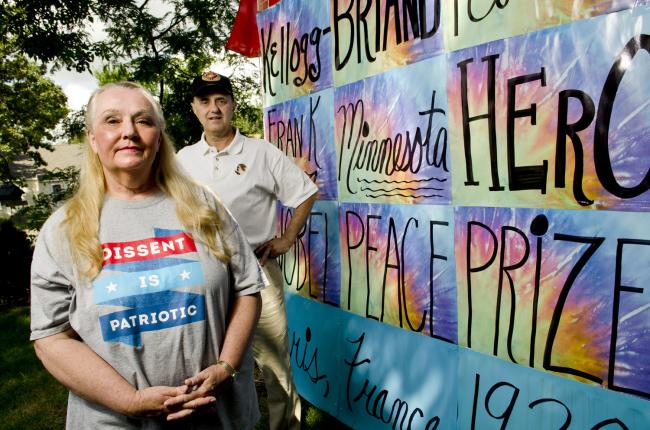
The Minnesota Supreme Court has tossed out a disorderly conduct law aimed at people who disrupt public meetings.
The Court ruled in the case of Robin Hensel, of Little Falls, who was cited for disorderly conduct after she moved her chairs closer to city councilors at a meeting, days after the Council rescheduled a meeting when Hensel displayed signs that depicted dead and deformed children, blocking the view of others in the audience.
She was convicted after a judge refused to allow her to enter a defense under the First Amendment.
“The Court has made clear that “the First Amendment does not guarantee the right to communicate one’s views at all times and places or in any manner that may be desired,” Court of Appeals Judge Michelle Ann Larkin ruled last year upholding the conviction.
Today, the Minnesota Supreme Court overruled the Court of Appeals, ruling the statute about disturbing public meetings is overly broad (See full opinion).
Here’s how the law reads:
Whoever does any of the following in a public or private place, including on a school bus, knowing, or having reasonable grounds to know that it will, or will tend to, alarm, anger or disturb others or provoke an assault or breach of the peace, is guilty of disorderly conduct, which is a misdemeanor:
. . .
(2) disturbs an assembly or meeting, not unlawful in its character . .
“An individual could violate the statute by, for example, wearing an offensive t-shirt, using harsh words in addressing another person, or even raising one’s voice in a speech,” Justice David Stras wrote for the majority in today’s opinion.
This statute presents us with a “criminal prohibition of alarming breadth.” Stevens, 559 U.S. at 474. It criminalizes a public speech that “criticize[s] various political and racial groups . . . as inimical to the nation’s welfare.” It prohibits an individual from wearing a jacket containing an offensive inscription to a meeting. And certainly, it would forbid someone from burning the American flag on a public street.
In addition to being disruptive of gatherings of all kinds, all of these actions share a common quality: they are protected under the First Amendment. Due to the countless ways in which [the law] can prohibit and chill protected expression, we conclude that the statute facially violates the First Amendment’s overbreadth doctrine.
In a dissent joined by Chief Justice Lorei Gildea, Justice G. Barry Anderson said the court should have interpreted the statute more narrowly, rather than throwing it out.
In this case, he said, the court could have said the law targets conduct, not content.
Indeed, under the narrowing construction that I urge we adopt, many of the troubling applications of the statute the court mentions would no longer be criminalized.
For example, the court concludes that the disorderly conduct statute prohibits “criticiz[ing] various political and racial groups . . . as inimical to the nation’s welfare,” which is protected under Terminiello v. City of Chicago. But the narrowed construction urged here limits the reach of the statute to conduct, not speech.
The court worries that the disorderly conduct statute criminalizes wearing a jacket with an offensive description, which is protected under Cohen v. California. But this, too, would be outside the reach of the statute as narrowly construed because, as the Supreme Court of the United States concluded, Cohen’s jacket was simply written speech, not conduct.
Stras agreed that would settle the First Amendment violations, but it would be unworkable.
A straightforward example illustrates the point. In this case, Hensel displayed signs with pictures of dead and deformed children during the first of the two Little Falls City Council meetings.
Suppose that the State had prosecuted Hensel solely because of her decision to display the controversial signs at the first meeting, not her later decision to sit in the area between the gallery and the dais during the second meeting.
Under such a scenario, the factfinder would need to disentangle whether the cause of the disruption was her decision to display the signs, which blocked the view of other members of the public, or the message on the signs, which contained graphic images. Yet in many cases, the answer is likely both, leaving the jury with the thorny task of attempting to differentiate between the two in a disorderly-conduct case.
Stras said Anderson and Gildea’s proposed solution constitutes a “shave-a-little-off-here and throw-in-a-few-words-there statute” that would bear little resemblance to the law the Legislature actually passed.
That’s a law that is now dead.
“We’re at a time in our history where our democratic norms and values are under attack and it’s critical that people be able to publicly dissent and hold their government accountable,” Hensel’s attorney, Kevin Riach, said. “This decision takes a tool away from those who would seek to squash that dissent.”
